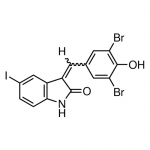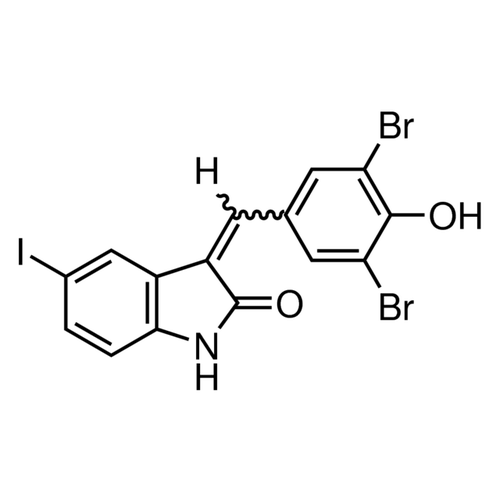| Product Name | GW5074 |
| Description |
c-Raf1 kinase inhibitor |
| Purity | >98% (TLC) |
| CAS No. | 220904-83-6 |
| Molecular Formula | C15H8Br2INO2 |
| Molecular Weight | 520.9 |
| Field of Use | Not for use in humans. Not for use in diagnostics or therapeutics. For in vitro research use only. |
Properties
| Storage Temperature | -20ºC |
| Shipping Temperature | Shipped Ambient |
| Product Type | Inhibitor |
| Solubility | Soluble to 1 mM in ethanol and to 100 mM in DMSO |
| Source | Synthetic |
| Appearance | Yellow to orange solid |
| SMILES | C1=CC2=C(C=C1I)/C(=C/C3=CC(=C(C(=C3)Br)O)Br)/C(=O)N2 |
| InChI | InChI=1S/C15H8Br2INO2/c16-11-4-7(5-12(17)14(11)20)3-10-9-6-8(18)1-2-13(9)19-15(10)21/h1-6,20H,(H,19,21)/b10-3- |
| InChIKey | LMXYVLFTZRPNRV-KMKOMSMNSA-N |
| Safety Phrases |
Classification: Not a hazardous substance or mixture. Safety Phrases: S22 - Do not breathe dust. S24/25 - Avoid contact with skin and eyes. S36/37/39 - Wear suitable protective clothing, gloves and eye/face protection. |
| Cite This Product | GW5074 (StressMarq Biosciences Inc., Victoria BC CANADA, Catalog # SIH-451) |
Biological Description
| Alternative Names | 3-(3,5-Dibromo-4-hydroxybenzyliden)-5-iodo-1,3-dihydroindol-2-one |
| Research Areas | Apoptosis, Cancer, Cancer Growth Inhibitors, Cell Signaling, Tyrosine Kinase Inhibitors |
| PubChem ID | 5924208 |
| Scientific Background | GW5074 is a potent and selective inhibitor of c-Raf1 kinase, showing over 100-fold selectivity over other kinases such as CDK1, ERK2, and VEGFR2. In neuroscience, GW5074 is used to study Raf/MEK/ERK signaling in neuronal survival, differentiation, and apoptosis. It has been shown to block low potassium-induced cell death and prevent neurodegeneration. GW5074’s ability to modulate MAPK signaling makes it a key compound for exploring neuroprotective mechanisms and therapeutic targets in neurodegenerative diseases. |
| References |
1. Chin P.C., et al. (2004) J. Neurochem. 90(3): 595–608. 2. Lackey K., et al. (2000). Bioorganic Med. Chem. Ltr. 10(3): 223–226. 3. Chang M.S., (2005). Cell Signal. 17(3): 299–310. |



Reviews
There are no reviews yet.